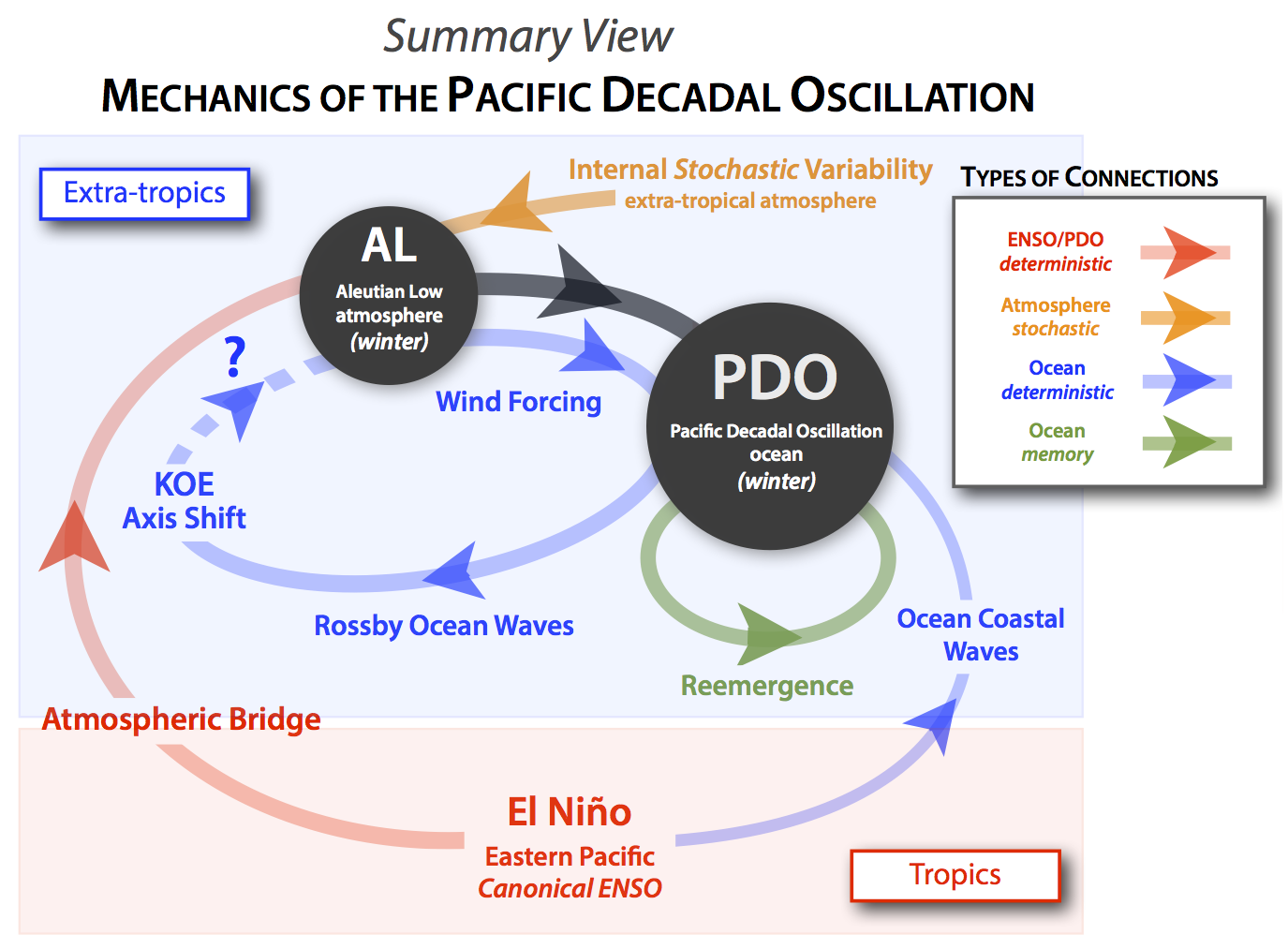The Pacific Decadal Oscillation – revisited

Since its identification in the late 1990’s as the dominant year-round pattern of monthly North Pacific sea surface temperature (SST) variability, the Pacific decadal oscillation (PDO) [Mantua et al., 1997; Zhang et al., 1997] has been connected both to other parts of the climate system and to impacts on natural resources and marine and terrestrial ecosystems in North America and Asia. However, despite its North Pacific focus, the related PDO global pattern (Figure 1) has substantial similarity to El Niño Southern Oscillation (ENSO) – the largest signal of interannual variability in earth’s climate.
Recent research by Newman et al. (2016) has found that the PDO is not a single physical mode of climate variability but instead largely represents the combination of three groups of processes, illustrated in Figure 2: (1) changes in ocean surface heat fluxes and Ekman (wind-driven) transport related to the Aleutian low, due to both local unpredictable weather noise (orange path) and to remote forcing from interannual to decadal tropical variability (largely El Niño) via the “atmospheric bridge” (red path); (2) ocean memory, or processes determining oceanic thermal inertia including “re-emergence”, that act to integrate this forcing and generate the decadal variability of the PDO (green path); and (3) decadal changes in the Kuroshio-Oyashio current system, forced by winds over the North Pacific driving westward propagating oceanic Rossby waves, manifested as SST anomalies along the subarctic front at about 40ºN in the western Pacific ocean (blue path). Thus, the PDO represents the effects of different processes operating on different timescales, and its apparent impacts elsewhere only partly represent direct forcing of the atmosphere by the North Pacific Ocean.
An important goal of the Newman et al. (2016) study is to provide a mechanistic framework so that future interdisciplinary research using the PDO index for diagnosis or prediction is better positioned to investigate interactions between the PDO and the targeted biological, chemical or physical process. To this end the study highlights the importance of distinguishing “climate impacts correlated with the PDO from climate impacts that are predictable by the PDO … since much of the PDO represents the oceanic response to atmospheric forcing, care should be taken when using the PDO as a forcing function of non-oceanic responses without a convincing argument for the physical forcing mechanism.” What this means is that a correlation with the PDO does not necessarily imply that the PDO is the driver but more likely that there is a common forcing function shared between the PDO and the process being investigated.
The PDO is a “pattern of variance” that explains only a fraction of the climate variability of the North Pacific. In contrast, the mechanisms that make up the PDO are more general and can generate variance also on other patterns of North Pacific climate variability such as the North Pacific Gyre Oscillation (NPGO; see synthesis of Di Lorenzo et al., 2013). Focusing on these large-scale mechanisms is important not only for diagnosing the dynamics underlying relationships between climate indices (e.g. PDO and NPGO) and other observed regional processes, but also to explore the sensitivity of North Pacific climate to perturbation in its mean state (e.g. climate trend associated with greenhouse forcing).
Figure 1: Pacific decadal oscillation (PDO) over the historical record (1901-2014). Regression of global monthly SST (shading) and DJF SLP (contours; interval is 1 hPa) anomalies onto the PDO time series from the HadISST dataset. [Source Figure 1 of Newman et al. 2016].
Figure 2: The processes that make-up the PDO. ENSO atmospheric teleconnections (red-path), ocean waves (blue-path), atmospheric stochastic variability in the North Pacific (orange-path), and the reemergence of temperature anomaly from below the mixed layer (green path). With the exception of the reemergence and of the coastal waves, most of these processes impact the PDO by influencing changes in the Aleutian Low, which is the main driver of the PDO (grey-path). [Source Figure 14 of Newman et al. 2016].
References
Di Lorenzo, E., et al. (2013), Synthesis of Pacific Ocean Climate and Ecosystem Dynamics, Oceanography, 26(4), 68-81.
Mantua, N. J., S. R. Hare, Y. Zhang, J. M. Wallace, and R. C. Francis (1997), A Pacific interdecadal climate oscillation with impacts on salmon production, Bulletin of the American Meteorological Society, 78(6), 1069-1079, doi:10.1175/1520-0477(1997)078<1069:apicow>2.0.co;2.
Newman, M., M. Alexander, T. R. Ault, K. M. Cobb, C. Deser, E. Di Lorenzo, and e. al. (2016), The Pacific decadal oscillation, revisited, J. Clim., in press.
Zhang, Y., J. M. Wallace, and D. S. Battisti (1997), ENSO-like interdecadal variability: 1900-93, Journal of Climate, 10(5), 1004-1020, doi:10.1175/1520-0442(1997)010<1004:eliv>2.0.co;2.
Summary written by Emanuele Di Lorenzo and Kim M. Cobb.
The Pacific decadal oscillation, revisited (Journal of Climate, 2016, in press)
Matthew Newman1,2,*, Michael A. Alexander2, Toby R. Ault3, Kim M. Cobb4, Clara Deser5, Emanuele Di Lorenzo4, Nathan J. Mantua6, Arthur J. Miller7, Shoshiro Minobe8, Hisashi Nakamura9, Niklas Schneider10,Daniel J. Vimont11, Adam S. Phillips5, James D. Scott1,2, and Catherine A. Smith1,2
1 CIRES, University of Colorado, Boulder, Colorado
2 NOAA Earth Systems Research Laboratory, Boulder, Colorado
3 Department of Earth and Atmospheric Sciences, Cornell University, Ithaca, New York
4 School of Earth and Atmospheric Sciences, Georgia Tech, Atlanta, Georgia
5 Climate and Global Dynamics, National Center for Atmospheric Research, Boulder, Colorado
6 NOAA Southwest Fisheries Science Center, Santa Cruz, California
7 Scripps Institution of Oceanography, La Jolla, California
8 Graduate School of Science, Hokkaido University, Sapporo, Japan
9 Research Center for Advanced Science and Technology, The University of Tokyo, Tokyo, and Application Laboratory, JAMSTEC, Yokohama, Japan
10 Department of Oceanography and International Pacific Research Center, University of Hawai’i at Manoa, Honolulu, Hawaii
11 Department of Atmospheric and Oceanic Sciences, and Nelson Institute Center for Climatic Research, University of Wisconsin-Madison, Madison, Wisconsin
Published Online: 10 March, 2016














Add new comment